Work safely at heights in construction
Falls from heights are the number one cause of traumatic fatalities in the NSW building and construction industry.
One wrong step could be your last. Falls from 2 to 4 metres can be devastating and often fatal.
SafeWork inspectors now targeting work at heights safety on construction sites across the state.
Do work safety right, at any height
Employers must protect workers from the risk of falling from one level to another – no matter the height.
Use these resources to help make your workplace safe.
- Code of practice: Managing the risk of falls at workplaces (PDF, 2326.56 KB)
- Code of practice: Managing the risk of falls in housing construction (PDF, 2296.79 KB)
- Safety checklist - Working at heights in construction
(PDF, 208.69 KB) - The pocket guide to construction safety (PDF, 1352.71 KB)
- Webinar: Working safely at heights in construction
- Poster - Prevent falls from heights (PDF, 2419.61 KB)
- Working at heights in construction safety checklist (PDF, 208.69 KB)
This is a recording of a webinar presented by SafeWork NSW. The webinar explains the legislative requirements to manage working at height risks. It also looks at past incidents and statistics to you assist with compliance.
Key safety measures
Falls from heights are entirely preventable if you follow these steps:
- Work on the ground or on a solid construction where possible.
- Prevent your workers from falling by using a fall-prevention device, such as:
- temporary work platforms
- temporary roof edge protection
- scaffolding.
- Use a work-positioning system, such as:
- a restraint system
- industrial rope access.
- If it is not possible to use a fall prevention device or a work positioning system, use a fall arrest system, such as:
- industrial safety nets
- catch platforms
- harness-based fall-arrest used with lifelines or individual anchors.
- Complete a safe work method statement (PDF, 4004.58 KB) (SWMS) for work where a person could fall more than 2 metres.
Go to the Working at heights page in the A-Z hazards library
If you are a small business owner in NSW, the $1,000 SafeWork small business rebate will help you purchase safety items to improve work health and safety for you and your workers.
Work safely on ladders
A frame ladders
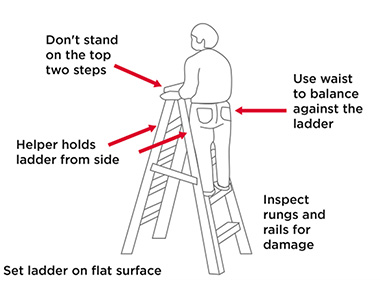
Many workers fall from A-frame style step ladders because they were working from the top two rungs, or over-reaching.
- Make sure your ladder is tall enough so you don’t have to stand on the top two rungs (standing on the upper two rungs de-stabilises the ladder).
- Ensure the ladder is rated for industrial use, is well maintained, and free of obvious visual defects (cracks, significant bending, missing rivets/fasteners etc).
- Make sure the ground is solid and level so that all 4 feet of the ladder are in contact with the ground when set up.
- Ensure all locking devices (legs or bracket) on the ladder are secured.
- When working on the ladder, have both feet and one other point of contact i.e. hand, waist or upper torso.
- Don’t overreach. Move the ladder if you need to. Never lean so far that your belt buckle is outside the ladder stiles.
Extension ladders
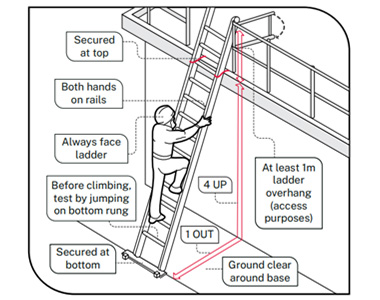
Many falls from extension ladders are because the ladder slipped outwards or sideways.
- Make sure your ladder is tall enough for the job. If you are using it to access a roof or another level, it needs to extend at least 1 metre past the landing. If you are using it to access a roof or another level, it needs to extend at least 1 metre past the landing.
- Make sure it is rated for industrial use and in good working order.
- Set it up so that it is not too close or too far from the support structure. The ratio should be 4:1. That means the base of the ladder is 1 metre away from the supporting structure, for every 4 metres of height.
- Wherever possible the ladder should be secured at the top and bottom.
- When climbing face the ladder, have both hands free to grip the ladder, and have at least one hand and one foot in contact with the ladder at all times.
- When working on the ladder, have both feet and one other point of contact i.e. hand, waist or upper torso.
- Use a tool pouch or similar if you need to carry tools.
Ladder resources
- Toolbox talk: Using ladders in construction. The toolbox talk is also available in the following languages:
- Step up your ladder safety - Poster
(PDF, 3525.37 KB) - Video: Safe use of ladders
- The pocket guide to ladder safety (PDF, 1104.94 KB)
Keep you and your work mates safe. Our Speak Up Save Lives app lets you report an unsafe work situation, while giving you the choice to remain anonymous.
Work safely on roofs
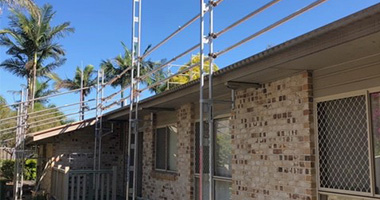
The biggest risks for roof work are falling off the edge or through fragile roof materials. Safety measures include using:
- a physical barrier, such as a temporary roof edge protection system or scaffold
- skylight covers, crawl boards, or physically marked exclusion zones for fragile surfaces.
After completing a risk assessment and consulting with your workers, you need to determine if the use of a fall prevention system is possible. If it is not possible, only then should a harness-based restraint system or fall arrest system be considered. You need to be adequately trained in these systems before use.
Temporary roof edge protection, skylight covers and crawl boards are quick and easy to install. They are cost-effective and you can re-use them.
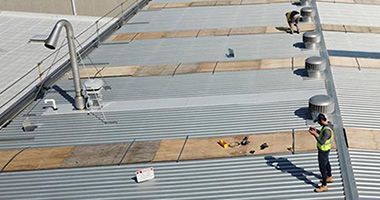
Roof resources
If you work on roofs, download the temporary edge protection (roof rails) fact sheet (PDF, 2885.66 KB). The fact sheet is also available in the following languages:
Are you installing solar panels? Learn more about installing solar panels safely.
Listen and learn. SafeWork NSW SafetyCasts are podcasts presented by NSW Inspectors for the building and construction industry. There are a range of topics to choose from.
Work safely around voids and penetrations
Most falls through voids and penetrations occur because they were uncovered or there was no guard rail in place.
- Make sure all voids and penetrations have a clearly marked cover that is secured so it can’t be dislodged. Plywood that is marked and screwed into the ground is a cost-effective solution.
- If the void/penetration is large or needed for temporary access, put in guard rails.
- If using the void/penetration to access another level, consider using temporary stairs or make sure your ladder extends 1 metre past the landing point.
Incident animations
- Fall through void profiles an incident where a worker was seriously injured after falling through an unprotected stairwell void at a residential construction site.
- Owner builder – fall through void is based on an actual incident involving a worker falling through a void on a residential construction site.
Videos
Working safely on scaffolds
The main risks with scaffold include falls from incomplete scaffolds, being hit by tools or materials that fall off them and scaffold collapse.
Tradies who don’t hold a scaffold licence must not erect, alter or dismantle a scaffold where the risk of a person or object falling is more than 4 metres.
These are some of the things that you should visually check from the ground, before using a scaffold:
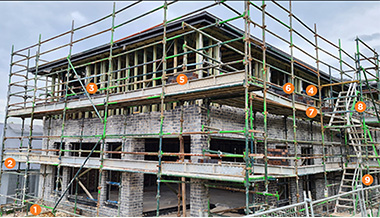
- Constructed on solid foundations (using 1 sole board preferably)
- Mesh installed to prevent debris falling onto neighbouring properties
- Diagonal bracing installed (every 4th bay)
- Adequately tied to the supporting structure
- Platforms are not overloaded with materials
- Handrails and mid-rails installed (to prevent external and internal falls)
- Kickboards installed to all working decks
- Safe access and egress onto stairs and between deck levels
- Scaff tag at scaffold entrance – showing last inspection no more than 30 days ago
Scaffolding resources
- Consult with your workers using our Toolbox talk: Using scaffolds (PDF, 690.33 KB). The toolbox talk is also available in the following languages:
- Download our scaffold safety checklist for site supervisors (PDF, 392.98 KB)
The Reducing falls from heights in the construction industry - June 2023 options paper (PDF, 1427.25 KB) explores the major findings of SafeWork NSW's initiatives to reduce falls since 2017.
The Findings Report: Work at Heights in Construction 2023/24 provides comprehensive data on safety trends.